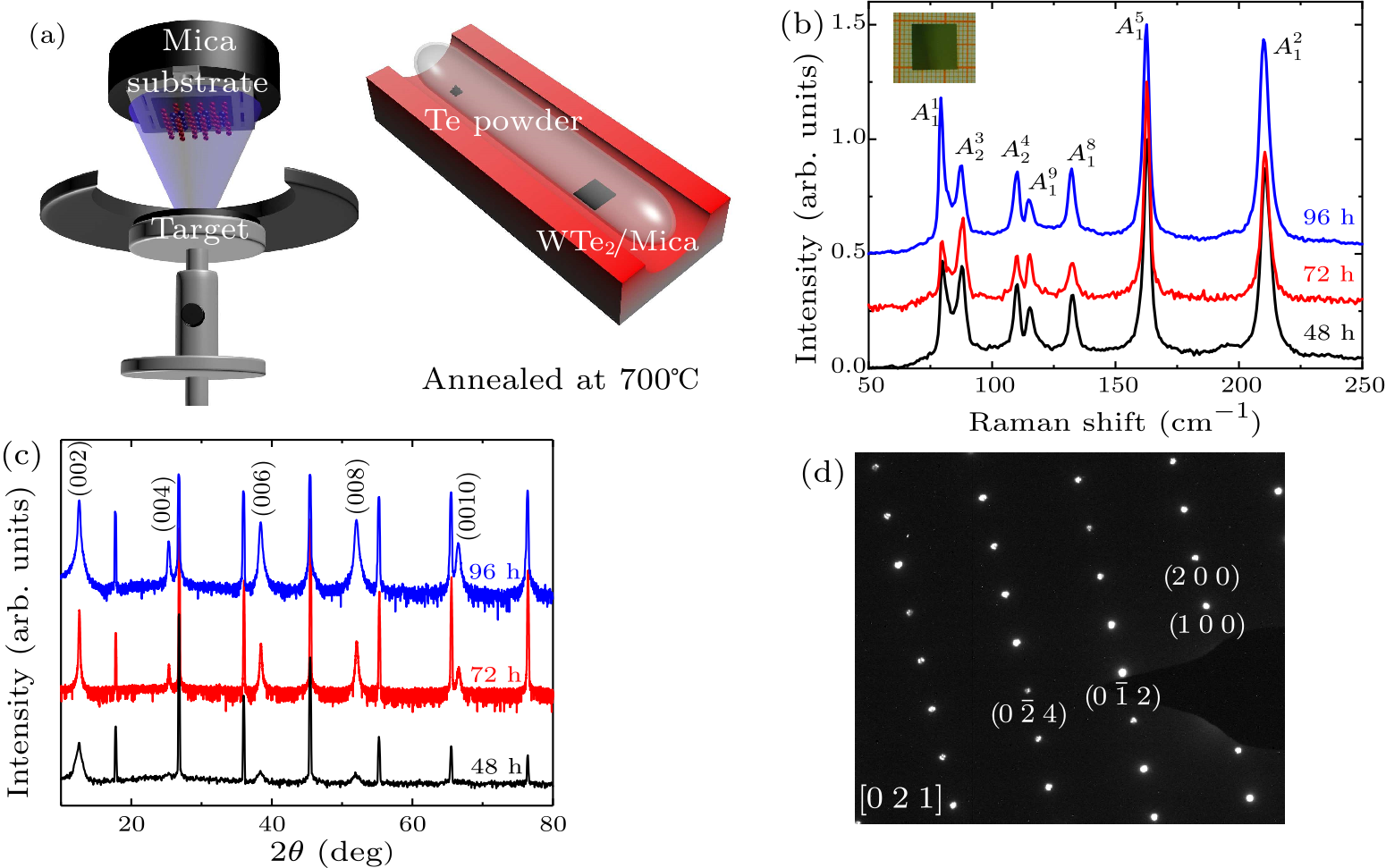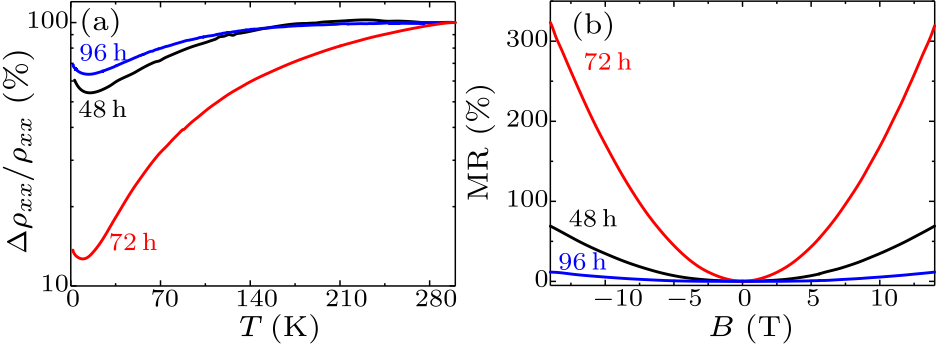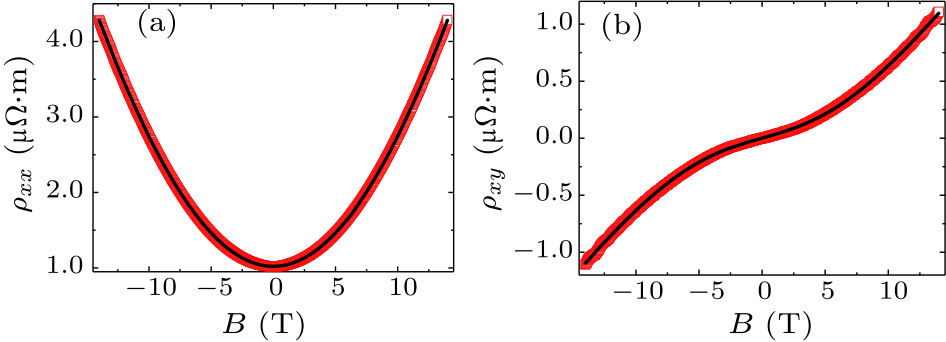
Fig. 1. Structural characterization of the WTe$_{2}$ films. (a) Schematic diagrams of the PLD and annealing apparatus. (b) Raman spectra of the WTe$_{2}$ films annealed for different time intervals. Inset shows the digital photograph of the centimeter-scale WTe$_{2}$ film. (c) XRD patterns of the WTe$_{2}$ films annealed for different time intervals. The WTe$_{2}$ film is characterized as (00$l$) family diffraction peaks while the other peaks belong to the mica substrate. (d) The SAED pattern taken along the [021] zone axis of the WTe$_{2}$ film annealed for 72 hours.

Fig. 2. (a) The temperature dependence of the longitudinal resistivity of the WTe$_{2}$ films annealed for different time intervals, as normalized by their values at 300 K. (b) The MR curves of the WTe$_{2}$ films annealed for different time intervals at 1.7 K.

Fig. 3. (a) The MR curves of the WTe$_{2}$ film annealed for 72 hours at different temperatures. (b) Temperature dependence of SdH oscillations after a smooth subtraction of background. (c) The FFT of the SdH oscillations. Inset: the relationship between Landau level $n$ and the inverse field 1/$B$. (d) The temperature dependence of FFT amplitude at 175.4 T, as normalized by the value at 1.7 K. (e) The Dingle plot of the $\log(\Delta R\cdot B\cdot \sinh (\lambda Tm^*/B)/R)$ versus the inverse field 1/$B$ at 1.7 K.

Fig. 4. Field-dependent longitudinal resistivity (a) and Hall resistivity (b) of the WTe$_{2}$ film annealed for 72 hours at 1.7 K. The black lines are the fitting curves by the two-carries model.
| [1] | Schubnikow L and Haas W J d 1930 Proc. Neth. R. Acad. Sci. 33 130 |
| [2] | Shoenberg D 2009 Magnetic Oscillations in Metals (Cambridge: Cambridge University Press) |
| [3] | Chakravarty S and Kee H Y 2008 Proc. Natl. Acad. Sci. USA 105 8835 | Fermi pockets and quantum oscillations of the Hall coefficient in high-temperature superconductors
| [4] | Tang F, Po H C, Vishwanath A et al 2019 Nature 566 486 | Comprehensive search for topological materials using symmetry indicators
| [5] | Zhang T, Jiang Y, Song Z et al 2019 Nature 566 475 | Catalogue of topological electronic materials
| [6] | Vergniory M G, Elcoro L, Felser C et al 2019 Nature 566 480 | A complete catalogue of high-quality topological materials
| [7] | Shekhar C, Nayak A K, Sun Y et al 2015 Nat. Phys. 11 645 | Extremely large magnetoresistance and ultrahigh mobility in the topological Weyl semimetal candidate NbP
| [8] | Zhang H, Liu C X , Qi X L et al 2009 Nat. Phys. 5 438 | Topological insulators in Bi2Se3, Bi2Te3 and Sb2Te3 with a single Dirac cone on the surface
| [9] | Petrushevsky M, Lahoud E, Ron A et al 2012 Phys. Rev. B 86 045131 | Probing the surface states in Bi Se using the Shubnikov–de Haas effect
| [10] | Xiang Z J, Zhao D, Jin Z et al 2015 Phys. Rev. Lett. 115 226401 | Angular-Dependent Phase Factor of Shubnikov–de Haas Oscillations in the Dirac Semimetal
| [11] | Ali M N, Xiong J, Flynn S et al 2014 Nature 514 205 | Large, non-saturating magnetoresistance in WTe2
| [12] | Wang C M, Lu H Z and Shen S Q 2016 Phys. Rev. Lett. 117 077201 | Anomalous Phase Shift of Quantum Oscillations in 3D Topological Semimetals
| [13] | Wang C M, Sun H P, Lu H Z et al 2017 Phys. Rev. Lett. 119 136806 | 3D Quantum Hall Effect of Fermi Arcs in Topological Semimetals
| [14] | Pletikosic I, Ali M N, Fedorov A V et al 2014 Phys. Rev. Lett. 113 216601 | Electronic Structure Basis for the Extraordinary Magnetoresistance in
| [15] | Kang D, Zhou Y, Yi W et al 2015 Nat. Commun. 6 7804 | Superconductivity emerging from a suppressed large magnetoresistant state in tungsten ditelluride
| [16] | Pan X C, Chen X, Liu H et al 2015 Nat. Commun. 6 7805 | Pressure-driven dome-shaped superconductivity and electronic structural evolution in tungsten ditelluride
| [17] | Wang Y, Liu E, Liu H et al 2016 Nat. Commun. 7 13142 | Gate-tunable negative longitudinal magnetoresistance in the predicted type-II Weyl semimetal WTe2
| [18] | Fei Z Y, Palomaki T, Wu S F et al 2017 Nat. Phys. 13 677 | Edge conduction in monolayer WTe2
| [19] | Tang S J, Zhang C F, Wong D et al 2017 Nat. Phys. 13 683 | Quantum spin Hall state in monolayer 1T'-WTe2
| [20] | Wu S F, Fatemi V, Gibson Q D et al 2018 Science 359 76 | Observation of the quantum spin Hall effect up to 100 kelvin in a monolayer crystal
| [21] | Fatemi V, Wu S F, Cao Y et al 2018 Science 362 926 | Electrically tunable low-density superconductivity in a monolayer topological insulator
| [22] | Sajadi E, Palomaki T, Fei Z Y et al 2018 Science 362 922 | Interface-Induced High-Temperature Superconductivity in Single Unit-Cell FeSe Films on SrTiO3
| [23] | Zhang E, Chen R, Huang C et al 2017 Nano Lett. 17 878 | Tunable Positive to Negative Magnetoresistance in Atomically Thin WTe 2
| [24] | Zhou J, Lin J, Huang X et al 2018 Nature 556 355 | A library of atomically thin metal chalcogenides
| [25] | Li J, Cheng S, Liu Z et al 2018 J. Phys. Chem. C 122 7005 | Centimeter-Scale, Large-Area, Few-Layer 1T′-WTe 2 Films by Chemical Vapor Deposition and Its Long-Term Stability in Ambient Condition
| [26] | Zhou J, Liu F, Lin J et al 2017 Adv. Mater. 29 1603471 | Large-Area and High-Quality 2D Transition Metal Telluride
| [27] | Asaba T, Wang Y, Li G et al 2018 Sci. Rep. 8 6520 | Magnetic Field Enhanced Superconductivity in Epitaxial Thin Film WTe2
| [28] | Jia Z Y , Song Y H , Li X B et al 2017 Phys. Rev. B 96 041108 | Direct visualization of a two-dimensional topological insulator in the single-layer
| [29] | Yao J D, Zheng Z Q and Yang G W 2019 Prog. Mater. Sci. 106 100573 | Production of large-area 2D materials for high-performance photodetectors by pulsed-laser deposition
| [30] | Gao M, Zhang M H, Niu W et al 2017 Appl. Phys. Lett. 111 031906 | Tuning the transport behavior of centimeter-scale WTe 2 ultrathin films fabricated by pulsed laser deposition
| [31] | Vermeulen P A, Momand J and Kooi B J 2019 CrystEngComm 21 3409 | Low temperature epitaxy of tungsten–telluride heterostructure films
| [32] | Kong W D, Wu S F , Richard P et al 2015 Appl. Phys. Lett. 106 081906 | Raman scattering investigation of large positive magnetoresistance material WTe 2
| [33] | Cai P L, Hu J, He L P et al 2015 Phys. Rev. Lett. 115 057202 | Drastic Pressure Effect on the Extremely Large Magnetoresistance in : Quantum Oscillation Study
| [34] | Lv Y Y, Zhang B B, Li X et al 2016 Sci. Rep. 6 26903 | Dramatically decreased magnetoresistance in non-stoichiometric WTe2 crystals
| [35] | Wang X, Du Y, Dou S et al 2012 Phys. Rev. Lett. 108 266806 | Room Temperature Giant and Linear Magnetoresistance in Topological Insulator Nanosheets
| [36] | Zhang M H, Wang X F, Zhang S et al 2016 IEEE Electron Device Lett. 37 1231 | The Unique Current-Direction Dependent On-Off Switching in BiSbTeSe2 Topological Insulator Based Spin Valve Transistors
| [37] | Yang Y K , Xiu F X , Wang F Q et al 2019 Chin. Phys. B 28 107502 | Electrical transport and optical properties of Cd 3 As 2 thin films
| [38] | Pan H, Zhang K, Wei Z et al 2016 Appl. Phys. Lett. 108 183103 | Quantum oscillation and nontrivial transport in the Dirac semimetal Cd 3 As 2 nanodevice
| [39] | Huang X W , Liu X X , Yu P et al 2019 Chin. Phys. Lett. 36 077101 | Magneto-Transport and Shubnikov–de Haas Oscillations in the Type–II Weyl Semimetal Candidate NbIrTe 4 Flake
| [40] | Fatemi V, Gibson Q D, Watanabe K et al 2017 Phys. Rev. B 95 041410 | Magnetoresistance and quantum oscillations of an electrostatically tuned semimetal-to-metal transition in ultrathin
| [41] | Novak M, Sasaki S, Segawa K et al 2015 Phys. Rev. B 91 041203 | Large linear magnetoresistance in the Dirac semimetal TlBiSSe